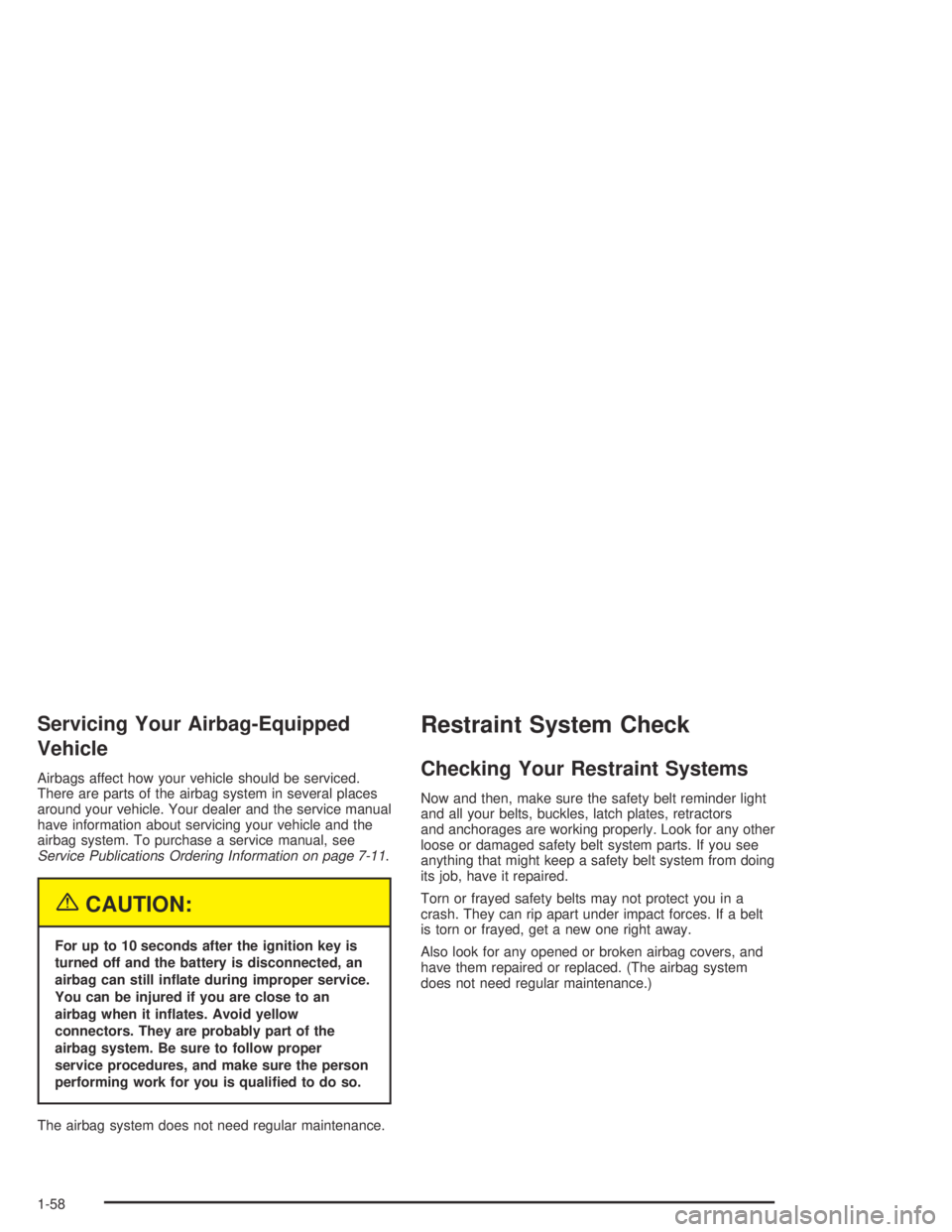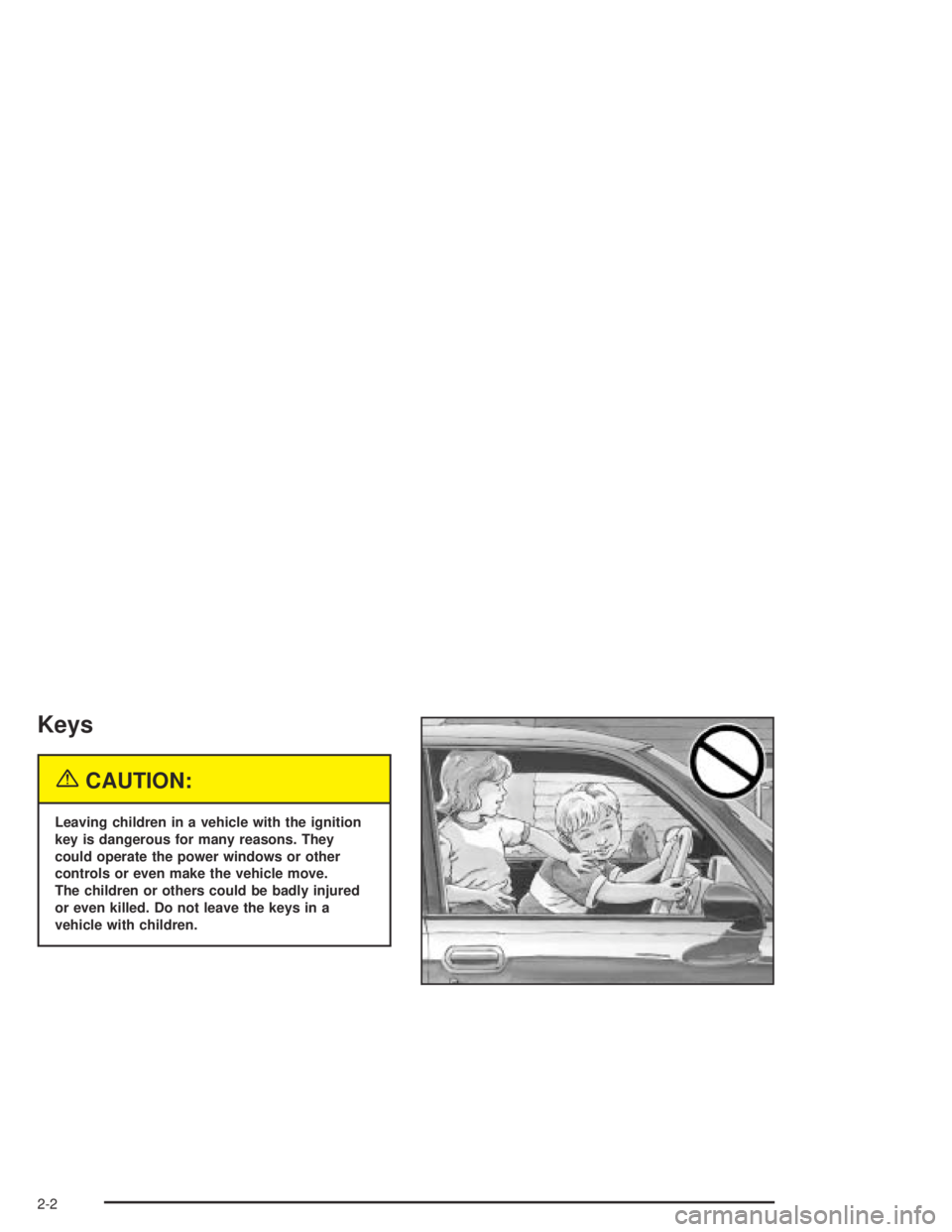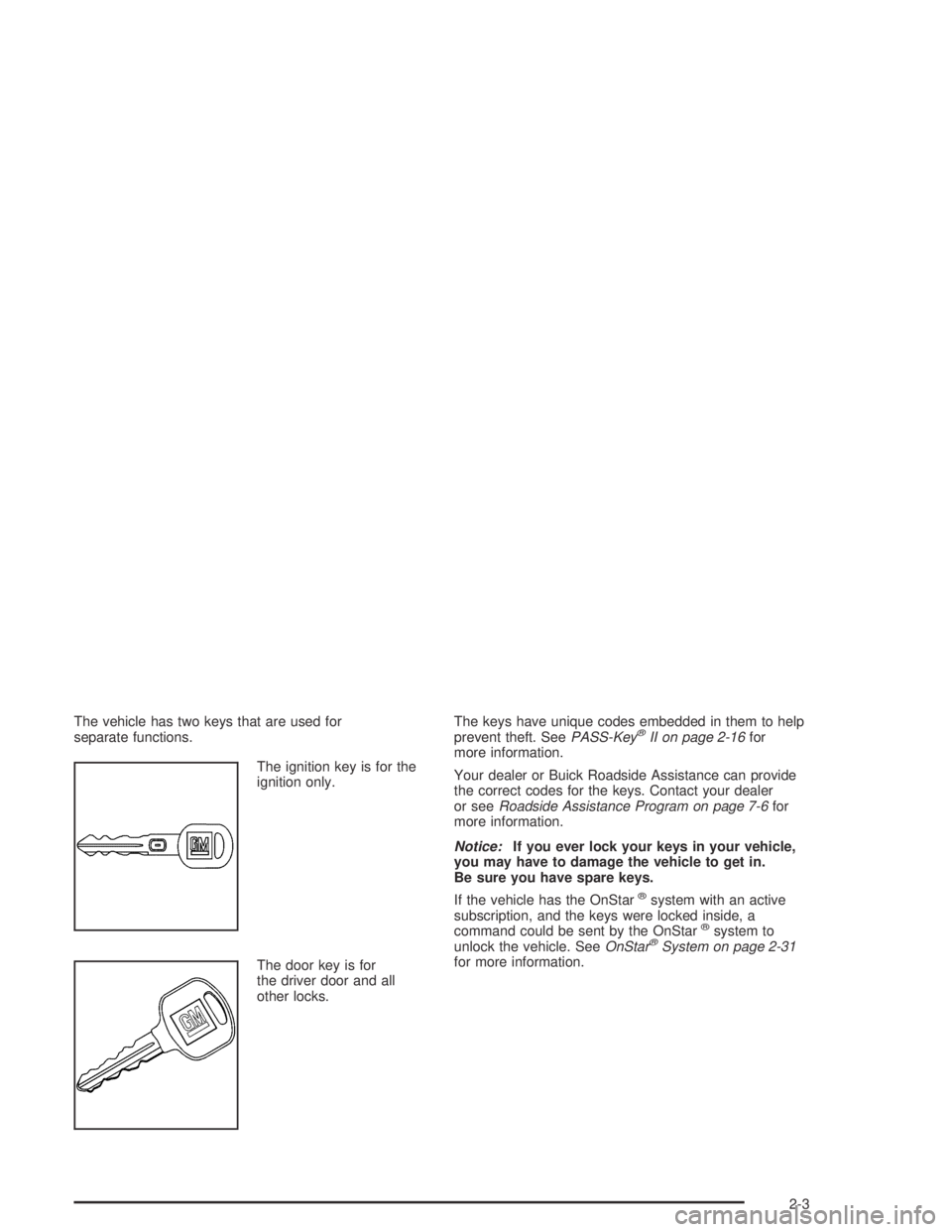2005 BUICK CENTURY ignition
[x] Cancel search: ignitionPage 64 of 348

Servicing Your Airbag-Equipped
Vehicle
Airbags affect how your vehicle should be serviced.
There are parts of the airbag system in several places
around your vehicle. Your dealer and the service manual
have information about servicing your vehicle and the
airbag system. To purchase a service manual, see
Service Publications Ordering Information on page 7-11.
{CAUTION:
For up to 10 seconds after the ignition key is
turned off and the battery is disconnected, an
airbag can still in�ate during improper service.
You can be injured if you are close to an
airbag when it in�ates. Avoid yellow
connectors. They are probably part of the
airbag system. Be sure to follow proper
service procedures, and make sure the person
performing work for you is quali�ed to do so.
The airbag system does not need regular maintenance.
Restraint System Check
Checking Your Restraint Systems
Now and then, make sure the safety belt reminder light
and all your belts, buckles, latch plates, retractors
and anchorages are working properly. Look for any other
loose or damaged safety belt system parts. If you see
anything that might keep a safety belt system from doing
its job, have it repaired.
Torn or frayed safety belts may not protect you in a
crash. They can rip apart under impact forces. If a belt
is torn or frayed, get a new one right away.
Also look for any opened or broken airbag covers, and
have them repaired or replaced. (The airbag system
does not need regular maintenance.)
1-58
Page 67 of 348

Keys...............................................................2-2
Remote Keyless Entry System.........................2-4
Remote Keyless Entry System Operation...........2-5
Doors and Locks............................................2-10
Door Locks..................................................2-10
Power Door Locks........................................2-11
Programmable Automatic Door Locks..............2-11
Lockout Protection........................................2-12
Leaving Your Vehicle....................................2-12
Trunk..........................................................2-12
Windows........................................................2-14
Power Windows............................................2-15
Sun Visors...................................................2-15
Theft-Deterrent Systems..................................2-16
PASS-Key
®II ...............................................2-16
Starting and Operating Your Vehicle................2-17
New Vehicle Break-In....................................2-17
Ignition Positions..........................................2-18
Retained Accessory Power (RAP)...................2-19Starting Your Engine.....................................2-19
Engine Coolant Heater..................................2-20
Automatic Transaxle Operation.......................2-21
Parking Brake..............................................2-24
Shifting Into Park (P).....................................2-25
Shifting Out of Park (P).................................2-26
Parking Over Things That Burn.......................2-27
Engine Exhaust............................................2-27
Running Your Engine While You Are Parked.......2-28
Mirrors...........................................................2-29
Manual Rearview Mirror.................................2-29
Manual Rearview Mirror with OnStar
®..............2-29
Outside Power Mirrors...................................2-30
Outside Convex Mirror...................................2-30
OnStar
®System.............................................2-31
Storage Areas................................................2-33
Glove Box...................................................2-33
Front Storage Area.......................................2-33
Convenience Net..........................................2-33
Section 2 Features and Controls
2-1
Page 68 of 348

Keys
{CAUTION:
Leaving children in a vehicle with the ignition
key is dangerous for many reasons. They
could operate the power windows or other
controls or even make the vehicle move.
The children or others could be badly injured
or even killed. Do not leave the keys in a
vehicle with children.
2-2
Page 69 of 348

The vehicle has two keys that are used for
separate functions.
The ignition key is for the
ignition only.
The door key is for
the driver door and all
other locks.The keys have unique codes embedded in them to help
prevent theft. SeePASS-Key®II on page 2-16for
more information.
Your dealer or Buick Roadside Assistance can provide
the correct codes for the keys. Contact your dealer
or seeRoadside Assistance Program on page 7-6for
more information.
Notice:If you ever lock your keys in your vehicle,
you may have to damage the vehicle to get in.
Be sure you have spare keys.
If the vehicle has the OnStar
®system with an active
subscription, and the keys were locked inside, a
command could be sent by the OnStar
®system to
unlock the vehicle. SeeOnStar®System on page 2-31
for more information.
2-3
Page 71 of 348

Remote Keyless Entry
System Operation
The remote keyless entry transmitter enables the
vehicle’s doors to be locked and unlocked, or the trunk
lid to be released, from about 3 feet (1 m) and up to
30 feet (9 m) away.
LOCK:Press the LOCK
button to lock all the doors.
UNLOCK:Press the UNLOCK button to unlock the
driver door and turn on the interior lamps. See
“Illumination on Remote Activation” later in this section
for more details. Press UNLOCK again to unlock
the passenger doors.
F(Trunk Release):To release the trunk lid, press
this button. The trunk will only unlock if the transaxle
is in PARK (P).
L(Remote Alarm):Press this button to activate an
alarm. The ignition must be in OFF or ACCESSORY for
the remote alarm to work. When the remote alarm
button is pressed, the headlamps will �ash, the horn will
sound repeatedly, and the interior lamps will turn on.
The alarms will turn off when one of the following occurs:
The remote alarm button on the remote keyless
entry transmitter is pressed a second time.
The ignition is moved to RUN.
The alarms have been on for about two minutes.
Security Feedback
The remote keyless entry transmitter can be
programmed so that when the LOCK or UNLOCK
button is pressed, the vehicle gives visual or audible
feedback con�rmation. Each lock or unlock command
veri�cation must be programmed individually. The
ignition must be OFF for this feature to work.
Disconnecting the vehicle’s battery for up to a year will
not affect the programmed mode.
2-5
Page 72 of 348

Programming the LOCK Command
One of four modes can be selected to con�rm a
LOCK command.
Mode 1 (One Chime):No Veri�cation
Mode 2 (Two Chimes):Horn Chirp
Mode 3 (Three Chimes):Headlamps Flash
Mode 4 (Four Chimes):Horn Chirp and
Headlamps Flash
The vehicle was originally programmed to Mode 3.
The mode may have been changed since then.
To determine the current lock mode, or to change the
lock mode, do the following:
1. Close all doors and turn the ignition key to RUN.
2. Press and hold the power door lock switch in
the LOCK position.
3. While holding the power door lock switch in the
LOCK position, press and release the remote
keyless entry transmitter LOCK button.
A series of one to four chimes will sound,
corresponding to the current lock mode.4. Press the remote keyless entry transmitter LOCK
button to advance to the next lock mode.
If cycled beyond Mode 4, the vehicle will enter
Mode 1.
5. To set a mode, release the power door LOCK
switch after the chime sequence of the desired
mode is heard.
Programming the UNLOCK Command
One of four modes can be selected to con�rm an
UNLOCK command.
Mode 1 (One Chime):No Veri�cation
Mode 2 (Two Chimes):Horn Chirp
Mode 3 (Three Chimes):Headlamps Flash
Mode 4 (Four Chimes):Horn Chirp and
Headlamps Flash
2-6
Page 73 of 348

The vehicle was originally programmed to Mode 3.
The mode may have been changed since then.
To determine the current unlock mode, or to change the
unlock mode, do the following:
1. Close all doors and turn the ignition key to RUN.
2. Press and hold the power door lock switch in
the unlock position.
3. While holding the power door lock switch in the
unlock position, press and release the remote
keyless entry transmitter UNLOCK button.
A series of one to four chimes will sound,
corresponding to the current unlock mode.
4. Press the remote keyless entry transmitter UNLOCK
button to advance to the next unlock mode.
If cycled beyond Mode 4, the vehicle will enter
Mode 1.
5. To set a mode, release the power door unlock
switch after the chime sequence of the desired
mode is heard.Delayed Locking
This feature can be turned on or off. It delays the
locking of the doors for �ve seconds after the LOCK
position on the power door lock, or the LOCK button on
the remote keyless entry transmitter is pressed and
the last door is closed.
If a door is opened before �ve seconds, the delayed
lock is cancelled. When all doors are closed again,
delayed locking begins again.
Three chimes will sound to indicate that this feature is
on. The chime will sound only when the key is not in the
ignition and a door is open.
To cancel delay locking, do any of the following:
Press the unlock portion of the power door
lock switch.
Press the UNLOCK button on the remote keyless
entry transmitter.
Press the LOCK portion of the power door lock
switch a second time.
Press the LOCK button on the remote keyless entry
transmitter a second time.
Insert the ignition key into the ignition.
2-7
Page 74 of 348

Programming Delayed Locking
Delayed locking has two modes.
Mode One (One Chime):Delayed locking is turned off.
Mode Two (Two Chimes):Delayed locking is
turned on.
1. Close the doors.
2. Move the ignition key to the RUN position.
3. Apply the regular brakes.
4. Press and hold the power door unlock switch. While
holding the power door unlock switch, move the
shift lever out of and back into PARK (P).
One or two chimes will sound indicating what mode
the delayed locking is in.
5. Release the power door unlock switch, after one
of the chime mode sequences, to set the
desired mode.
Illumination on Remote Activation
This feature provides interior lighting when a remote
keyless entry door unlock command is received by the
vehicle. The ignition must be off for this feature to
work. The interior lamps will stay on until either the
ignition is turned to RUN or until 40 seconds has
elapsed. If a door is opened during this time, the timed
lighting will be canceled, and the interior lamps will
remain on. Also see “Entry Lighting” underInterior
Lamps on page 3-15for more information.
Matching Transmitter(s) to
Your Vehicle
Each remote keyless entry transmitter is uniquely coded
to prevent another transmitter from unlocking your
vehicle. If a transmitter is lost or stolen, a replacement
can be purchased through your dealer. Remember
to bring any additional transmitters so they also can be
re-coded to match the new transmitter. Once your
dealer has coded the new transmitter, the lost
transmitter cannot unlock the vehicle. The vehicle can
have a maximum of four transmitters coded to it.
2-8